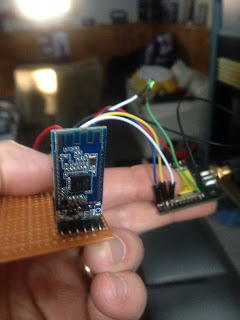The turbidity sensor enclosure that was described last week was completed this week, and a quick test in a shallow sink of water did not show any leaks or bubbles, so it looks like it will do the job for actual surface water turbidity measurements. It was 3D-printed in 3 sections, with O-rings between the sections and a cable gland on top for routing the power and data wires back to the rear enclosure of AMOS:
There is a small hole on the bottom for water to flow in and out of. Possibly this hole might need to be widened a bit, if it happens to get routinely plugged up with debris. The hole should be as small as possible though to prevent stray ambient light from interfering with the sensor readings.
Also this week, I got a small Bluetooth Low Energy (BLE) circuit board, the HM-10 that I wanted to hook up to the RFU220 radio that I am using to communicate with AMOS. The idea was to allow a smartphone to communicate to AMOS over the long range wireless RFU220 (up to about 3 miles according to the spec from Synapse). Smartphones do not typically allow cables to be plugged into them, so some sort of local wireless link (WiFi or Bluetooth) would be required to connect to the RFU220. The HM-10 that I got was pretty inexpensive (~ $5) so I figured it was worth a try. At first though, nothing seemed to be working. An LED on the HM-10 would turn on and blink at a 1 Hz rate, but that was it. After about 2 days of pouring over various manuals and Internet posts, I was eventually able to determine that I did not in fact have an HM-10 (although it was advertised as such on Amazon) but rather one of the many knock-offs that various companies have produced over the last 5 or 6 years. After some more searching through manuals and Internet posts, I was finally able to get it working, at least with my Android phone. I haven't tested it on the iPhone yet, but I'm assuming that that should work too.
The plan is to put these boards:
inside a small waterproof case that I won as a door prize a few years back. I'll need to add a small hole for the antenna, and will probably want to glue some pieces to the outside of it for mounting the smartphone. And I'll need to add 2 or 3 AA batteries inside the case too. The interior should still be waterproof, even with the antenna hole, and should also be able to float, so the phone won't sink if I happen to have a spill in the kayak.


Good idea for your phone!!
ReplyDeleteThanks! I was always a bit nervous last year about accidentally dropping it overboard. Luckily that never happened.😎
Delete